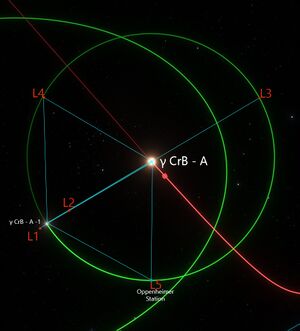Oppenheimer Station
Oppenheimer Station (also known as Oppenheimer Research Outpost) is a Regula Class station located in the Gamma Coronae Borealis system (abbreviated γ CrB).
The facility is fairly unusual in that it is anchored at the trailing L5 Lagrange point with its two parent bodies being the γ CrB - A star and the γ CrB - A1 planet . Over millennia the L5 Lagrange point has accumulated a large amount of stellar debris and dust resulting in the formation of a large Ionised dust cloud that resembles a small micro-nebula
Location
Oppenhiemer station is located in the Gamma Coronae Borealis system which is approximately 18 Light years coreward from Farpoint Station.
γ CrB is a binary star system containing a primary star ( γ CrB - A) of spectral classification F7 V and a secondary star ( γ CrB - B) of spectral classification M5 V.Orbital Characteristics
Oppenheimer station occupies the L5 Lagrange point in the orbit of γ CrB - A1. There are usually 5 Lagrange points where the gravitational pull of two massive bodies precatively match the centripetal required for a small object to move with them. In effect this allows a small object (a small station or starship) to remain fixed in space relative to its two parent bodies, with little to no additional energy required for station keeping. The L1. L2 and L3 points are considered "Unstable" and require very precise manoeuvring in order to occupy them for any length of time. The L4 and L5 points are much larger and are considered "Stable". They can accumulate matter and debris easily and retain it indefinitely due to the gravitational forces being at equilibrium in these regions; The L5 Lagrange point in particular has accumulated a large amount of stellar debris, forming a dense cloud of Ionised dust. Oppenheimer station is located within this cloud.

